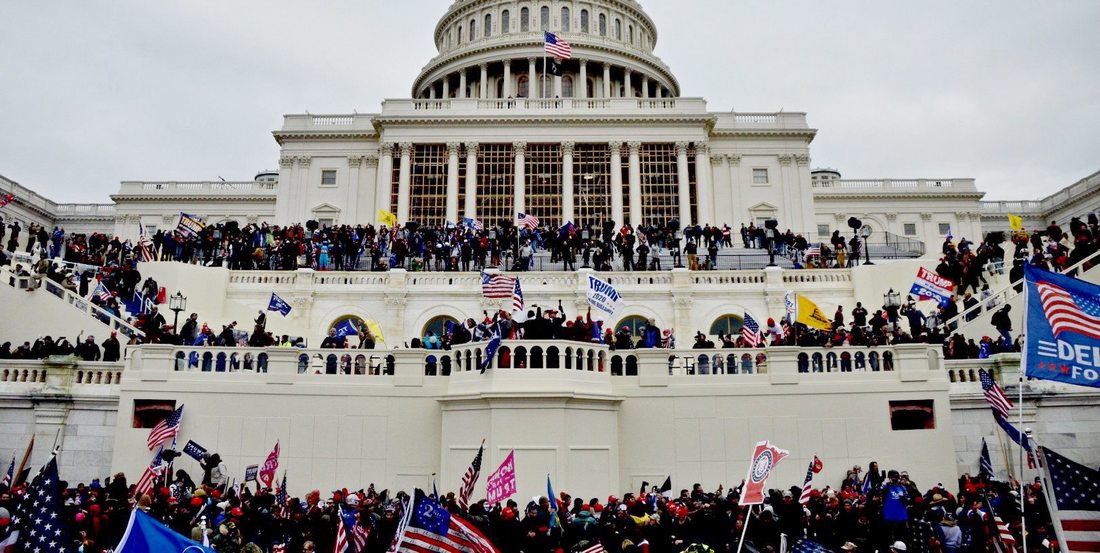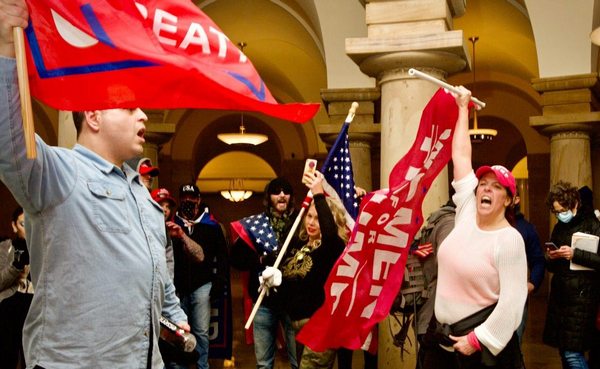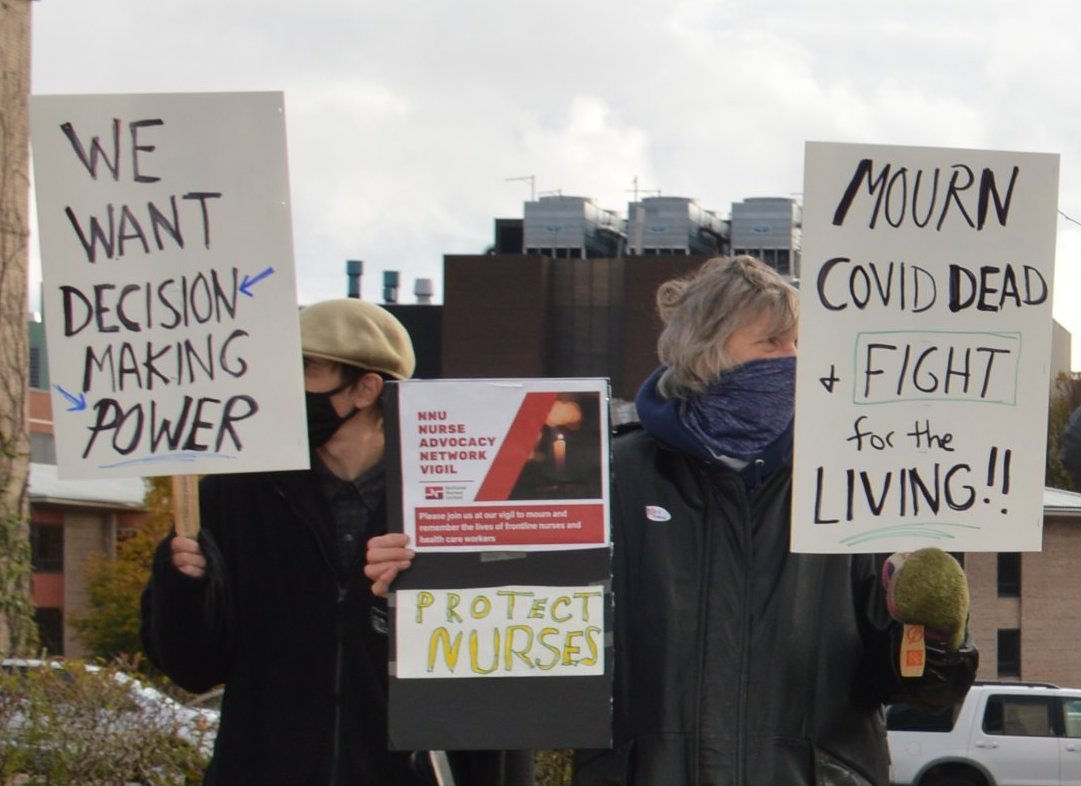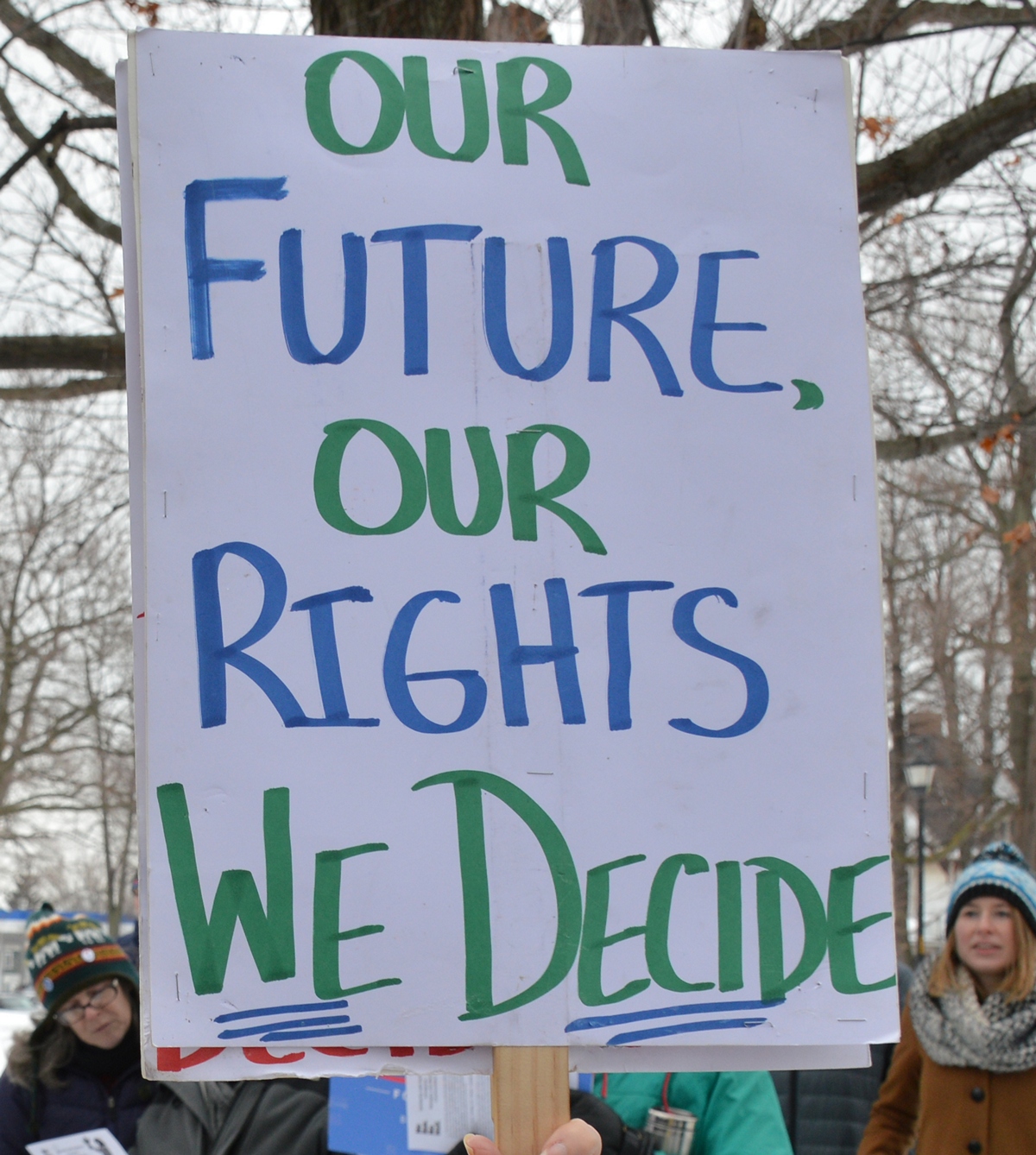January 6
Events in the United States What Is Relevant and
What Is
Not - Kathleen Chandler - 
Looking
at what took place at the Congress in Washington, DC on January 6,
there appears to be both a failed coup on the part of U.S. President
Donald Trump and an effort by President-Elect Joe Biden to use the
events to further strengthen the presidency by uniting the federal
policing and military bureaucracies behind him. Vice President Mike
Pence and Speaker of the House Nancy Pelosi are acting as enablers in
this effort. Pelosi for example, even though Trump is still
Commander-in-Chief of the U.S. armed forces, has publicly said she is
speaking with the military so they keep Trump from the "nuclear
button," as it is called. This is an effort to line the military up
behind Biden. We are
witnessing a counterrevolution within the long-standing
counterrevolution that has been ongoing since the collapse of the
Soviet Union.
What took place was not Trump vs.
democracy, as it
is being portrayed, as Trump also said he was acting to save the
Republic and its democracy. Rather it was the powers of the presidency
vs. the powers of Congress. It is an effort to further weaken Congress,
which already is dysfunctional and has conceded many of its powers,
such as declaring war and getting significant legislation passed. All
of the presidents since World War II have been increasing the strength
and powers of the presidency against those of Congress. This greatly
increased under Bill Clinton, George W. Bush and Obama and has reached
the point with Trump where a government of police powers has been
consolidated. Such a government has little regard for legislation and
laws and instead uses the Office to act with impunity, through use of
force, executive orders, etc. This is evident at home and abroad, where
Trump has repeatedly acted with impunity. Thus, crucial to
understanding what took place is how the use of force was deployed --
both the initial absence of police forces and their subsequent
deployment.
 People in the
U.S. and worldwide saw thousands of protesters carrying Trump and U.S.
flags and paraphernalia flood the steps of the Capitol building and go
inside, relatively unimpeded, while Congress was in session to certify
the Electoral College vote of the states. Despite the plan for rallies
at the Capitol and White House being known and in fact permitted, there
was an exceptionally small police presence. People in the
U.S. and worldwide saw thousands of protesters carrying Trump and U.S.
flags and paraphernalia flood the steps of the Capitol building and go
inside, relatively unimpeded, while Congress was in session to certify
the Electoral College vote of the states. Despite the plan for rallies
at the Capitol and White House being known and in fact permitted, there
was an exceptionally small police presence.
Commonly
for DC demonstrations there is a large police presence, with DC riot
police lining the streets, and streets near the rally points blocked
off. At the Capitol they would be present in lines two deep -- likely
armed with automatic rifles -- with more and heavier barricades, police
tanks, police on bicycles and horseback, a command centre, helicopters
and so forth. The Federal Bureau of Investigation (FBI), Drug
Enforcement Administration (DEA), the Bureau of Alcohol, Tobacco,
Firearms and Explosives (ATF), and Immigration and Customs Enforcement
(ICE) and other federal forces from the Department of Homeland Security
(DHS) are also usually present. All were absent at the time of the
rally on January 6, even though both Houses of Congress were in session
to certify the Electoral College vote -- something known to be in
contention. The relatively small Capitol Police force (numbering about
2,000) had responsibility to protect all the Congresspeople inside as
well as the building and other matters. DC
police, federal forces, and in this case the National Guard as well,
could only be absent by design. A decision is made in advance by those
with authority. All of the federal forces are put in action either by
the president himself, or by the head of DHS and FBI, Trump appointees.
For DC, the National Guard is also put in action by Trump, who for many
hours blocked their deployment, and they were finally called for by
Pence, not Trump. Orders go via the head of the Department of Defense
who, in this case, then
orders the Secretary of the Army Ryan McCarthy. McCarthy reported, "We
are in close contact with local and federal law enforcement agencies to
review potential additional support requirements for the DC National
Guard." All of these federal forces can act, and commonly do,
independent of the Capitol Police. When the
surge of Trump supporters breached the building, each House was in
their chamber in the process of debating the vote from Arizona, which
had been challenged by Senate and House members, led by Senators Ted
Cruz of Texas and Josh Hawley of Missouri. Vice President Pence, as
president of the Senate, was presiding over the Senate debate. Vice
President-Elect Kamala Harris was also present. Both were quickly
removed, likely by their own Secret Service details. Other
representatives were escorted out, many resorting to the "doomsday"
corridors -- the name referring to their intended use in the event of a
nuclear attack. Others were trapped inside the House chamber or their
offices with their staff. Video footage shows hundreds of protesters
wandering the chambers and halls, occupying offices, taking selfies
with police and seizing trophies. Still, reinforcements were nowhere to
be seen. Coup Attempt Unravels
Earlier that morning, thousands had rallied at the White
House, where Trump spoke. He said those present were "American patriots
... committed to the honesty of our elections and the integrity of our
glorious Republic... We will never give up. We will never concede." He
called on Pence to act, saying "All Vice President Pence has to do is
send it back to the States to recertify, and we become president." He
told protesters "You have to show strength" and then urged everyone to
march on the Capitol.
It is evident that to be
successful, Trump needed the support of Pence and other Republicans,
who he also urged to not certify the vote, as well as the armed forces
to not intervene. It is also evident that he and his cabinet provided
conditions for the protesters to march on the Capitol and enter it and
remain for several hours. The live test of support for the coup and a
readiness to use force as Trump commands unravelled throughout the day,
beginning with Pence declaring he could not use his position in the
Senate to call the election in Trump's favour, following which various
defections took place of those who, instead of supporting Trump, joined
Biden in calling on the President to re-establish order. This included
Chad Wolf, head of DHS, and National Security Adviser O'Brien, as well
as Senator Cruz and more and more Congresspeople. O'Brien said,
speaking of the protesters, "Violence has absolutely no place in our
democracy. Our country is better than what we saw today at our Capitol."
The Governor of Texas and the Texas District Attorney, both
major backers of Trump's efforts to overturn the elections, also
opposed. Former President George W. Bush represented the views of many
elected officials saying, "This is how election results are disputed in
a banana republic, not our democratic republic. I am appalled by the
reckless behaviour of some political leaders since the election and by
the lack of respect shown today for our institutions, our traditions
and our law enforcement." He emphasized that it is the "fundamental
responsibility of every patriotic citizen to support the rule of law."
Texas has significance in that the Governor has sizable
policing forces of his own and it is considered the tenth largest
economy in the world. The Bush family still has significant influence.
For Bush, the Governor and Senator Cruz to oppose Trump's action,
alongside Wolf of DHS, meant Trump could not succeed. The facts would
indicate that the military began coordinating with Pence. Acting
Defense Secretary Miller said, "Chairman Milley [of the Joint Chiefs of
Staff] and I just spoke separately with the Vice President and with
Speaker Pelosi, Leader McConnell, Senator Schumer and Representative
Hoyer about the situation at the U.S. Capitol. [...] We have fully
activated the DC National Guard to assist federal and local law
enforcement as they work to peacefully address the situation."
For any coup effort, the monopoly on the use of force is
essential. Trump made use of this and attempted to stage the coup with
the backing of the military and DHS, who coordinated with the DC
police, who follow federal commands in these situations. DC police are
not the ones in charge. This was evident when Police Chief Robert
Contee spoke hours after protesters were inside, with Army Secretary
McCarthy also present. As well, Contee reported that the DC police
responded to federal requests for support. That indicates the same
federal forces told them support was not initially needed. The
Demand to End All Police Violence and Put Control
in the
People’s Hands
There is a
deliberate effort to promote the problem with policing as a double
standard by police. Media repeatedly showed pictures of the National
Guard in full military gear guarding the Lincoln monument during
protests against police killings and impunity over the summer, along
with shots of tear gas and other state violence being used against
Black Lives Matter protesters and their allies. They also kept
repeating that the police were "caught by surprise" and were
"unprepared" while others said they should not have been unprepared
given foreknowledge of the rally. This
approach to the problem of double standards ignores that the key
problem is the monopoly on the use of force by state authorities to act
or not act -- and do both with impunity. While the people's movement
for justice is opposed to police impunity, the problem of police
violence is not that pro-Trump protesters should be treated with the
same violence as those fighting for justice. There
was a double standard evident with racist police violence against
resistance over the summer. Indeed, there is a double standard whenever
the state is protecting private interests while repressing those
resisting, whether African Americans, Puerto Ricans, Indigenous
peoples, workers, women or youth. The answer is not "equal" use of more
police state violence but an end to all such violence and control of
policing and monopoly on the use of force, and to put decision-making
power in the hands of the people themselves.
Crucial Issues of Who Decides and How
Decision-Making Power Is Wielded
Increasing
and ever more brutal use of police powers has characterized one
presidency after another, culminating with the Trump presidency, which
has gone beyond the pale for even his own supporters. What is at stake
in the current situation is who decides and how the decision-making
power is wielded. This is what is in dire crisis in the United States.
That private propertied interests control the use of force and all the
police powers that reside with the presidency is being systematically
revealed.  It
is notable that "both sides" -- Trump and the forces coming forward to
oppose those involved in the rampage -- all claim to be defending the
Constitution and put it forward as a solution to the present crisis.
Far from it, the Constitution and all its governing arrangements are
what have failed. U.S.-style democracy no longer functions to hold
anyone or anything to account. This is more than evident with this
immediate situation as well as government failures concerning COVID-19,
widespread unemployment, growing poverty and homelessness with more
evictions and job losses coming. U.S. democracy does not and cannot
provide for the rights of the people, including these most basic human
rights to housing, health care and a livelihood. Solutions cannot lie
with the governing arrangements that gave rise to the crisis in the
first place and that guarantee inequality and a lack of control over
decisions impacting the lives of the vast majority. It
is notable that "both sides" -- Trump and the forces coming forward to
oppose those involved in the rampage -- all claim to be defending the
Constitution and put it forward as a solution to the present crisis.
Far from it, the Constitution and all its governing arrangements are
what have failed. U.S.-style democracy no longer functions to hold
anyone or anything to account. This is more than evident with this
immediate situation as well as government failures concerning COVID-19,
widespread unemployment, growing poverty and homelessness with more
evictions and job losses coming. U.S. democracy does not and cannot
provide for the rights of the people, including these most basic human
rights to housing, health care and a livelihood. Solutions cannot lie
with the governing arrangements that gave rise to the crisis in the
first place and that guarantee inequality and a lack of control over
decisions impacting the lives of the vast majority.
It
is also worrisome that Trump and Biden both try to define who is and
who is not a patriot. Such efforts in the U.S. have a long history as a
means to target people fighting for rights as being "unAmerican" and
unpatriotic, words often used as synonyms to describe a terrorist.
Biden, like others, claims that what occurred is not "who we are." He
says, "For nearly two-and-a-half centuries, we, the people, in search
of a more perfect union, have kept our eyes on that common good.
America is so much better than what we've seen today." The reality is
that what everyone witnessed is exactly what the U.S. of the rich gives
rise to. Throughout those two-and-a-half centuries there have always
been two Americas contending -- that of the people against that of the
owners of private property who have concentrated power in their hands.
The Constitution is designed to keep these private interests in power.
The people have repeatedly fought against enslavement and inequality
and the "union" as defined by and for the propertied interests which
have seized control over the monopoly on the use of force. It
is clear that once the attempted coup failed, Biden, Pence, Cruz and
others in Congress sought to unify the contending forces within and
between the Presidency and federal policing and military bureaucracies.
This is necessary to preserve their "more perfect union" and is a
problem Trump failed to solve during his presidency. The numerous calls
for unity are part of this. Biden again reiterated his refrain that
anything can be done if "we do it together." He is seeking not only to
unify the contending forces among the rich but also to bring those
demanding equality and rights behind him. Nonetheless, the same
problems will haunt his presidency which will provide further proof
that the material conditions do not fall in line with the authority the
rulers wish for. While
the vote was certified and
Trump now says there will be a "peaceful transition," there is no basis
to think the source of conflicts and dysfunction of the system has
disappeared. The conflicts among the private interests exist as all
have self-serving interests and have made clear that the "common good,"
or "public good," is not to stand in their way. Further, it cannot be
said that the U.S. has been a "peaceful" force. There is instead a
history of wars, genocide and aggression. There is a war government and
war economy that cause grave harm and violence to the peoples at home
and abroad. What does occur is the transfer of power from one president
to the next, each more powerful than the last. Certainly the people are
not
accepting conditions where their rights are even further trampled and
where more violence and wars threaten. Their striving is for a peace
economy and anti-war government where the people decide.
Necessity for People's Empowerment
 There
is broad
recognition that for change that favours the people to take place, all
those responsible for creating the problems -- including Biden -- will
not be capable of providing solutions. Social responsibility rests with
the people as they step up their organizing efforts, within the many
collectives fighting for rights and more broadly within society as a
whole, to be political themselves by focusing on bringing into being a
decision-making process which is independent of the obsolete liberal
democratic institutions. There
is broad
recognition that for change that favours the people to take place, all
those responsible for creating the problems -- including Biden -- will
not be capable of providing solutions. Social responsibility rests with
the people as they step up their organizing efforts, within the many
collectives fighting for rights and more broadly within society as a
whole, to be political themselves by focusing on bringing into being a
decision-making process which is independent of the obsolete liberal
democratic institutions.
While
Biden claims the next four years are about the "the restoration of
democracy" -- that same failed democracy that is in tatters, the people
fighting for rights are making clear that what is needed is a people's
democracy, designed by the people themselves that empowers them to
govern and decide. Empowerment and control over decisions is being
taken up for solution, as collectives defending rights organize to
themselves make collective decisions, implement them and together
assess results. This struggle is altogether missing from the accounts
of the January 6 events.
Let us continue to unite in
action to
identify the problems which we think require solutions and how to
provide them with solutions!

This article was published in

Volume
51 Number 2 - January 10, 2021
Article Link:
What
Is Relevant and What Is Not
Website: www.cpcml.ca
Email: editor@cpcml.ca
|
 People in the
U.S. and worldwide saw thousands of protesters carrying Trump and U.S.
flags and paraphernalia flood the steps of the Capitol building and go
inside, relatively unimpeded, while Congress was in session to certify
the Electoral College vote of the states. Despite the plan for rallies
at the Capitol and White House being known and in fact permitted, there
was an exceptionally small police presence.
People in the
U.S. and worldwide saw thousands of protesters carrying Trump and U.S.
flags and paraphernalia flood the steps of the Capitol building and go
inside, relatively unimpeded, while Congress was in session to certify
the Electoral College vote of the states. Despite the plan for rallies
at the Capitol and White House being known and in fact permitted, there
was an exceptionally small police presence.  It
is notable that "both sides" -- Trump and the forces coming forward to
oppose those involved in the rampage -- all claim to be defending the
Constitution and put it forward as a solution to the present crisis.
Far from it, the Constitution and all its governing arrangements are
what have failed. U.S.-style democracy no longer functions to hold
anyone or anything to account. This is more than evident with this
immediate situation as well as government failures concerning COVID-19,
widespread unemployment, growing poverty and homelessness with more
evictions and job losses coming. U.S. democracy does not and cannot
provide for the rights of the people, including these most basic human
rights to housing, health care and a livelihood. Solutions cannot lie
with the governing arrangements that gave rise to the crisis in the
first place and that guarantee inequality and a lack of control over
decisions impacting the lives of the vast majority.
It
is notable that "both sides" -- Trump and the forces coming forward to
oppose those involved in the rampage -- all claim to be defending the
Constitution and put it forward as a solution to the present crisis.
Far from it, the Constitution and all its governing arrangements are
what have failed. U.S.-style democracy no longer functions to hold
anyone or anything to account. This is more than evident with this
immediate situation as well as government failures concerning COVID-19,
widespread unemployment, growing poverty and homelessness with more
evictions and job losses coming. U.S. democracy does not and cannot
provide for the rights of the people, including these most basic human
rights to housing, health care and a livelihood. Solutions cannot lie
with the governing arrangements that gave rise to the crisis in the
first place and that guarantee inequality and a lack of control over
decisions impacting the lives of the vast majority. There
is broad
recognition that for change that favours the people to take place, all
those responsible for creating the problems -- including Biden -- will
not be capable of providing solutions. Social responsibility rests with
the people as they step up their organizing efforts, within the many
collectives fighting for rights and more broadly within society as a
whole, to be political themselves by focusing on bringing into being a
decision-making process which is independent of the obsolete liberal
democratic institutions.
There
is broad
recognition that for change that favours the people to take place, all
those responsible for creating the problems -- including Biden -- will
not be capable of providing solutions. Social responsibility rests with
the people as they step up their organizing efforts, within the many
collectives fighting for rights and more broadly within society as a
whole, to be political themselves by focusing on bringing into being a
decision-making process which is independent of the obsolete liberal
democratic institutions.


